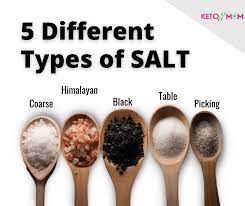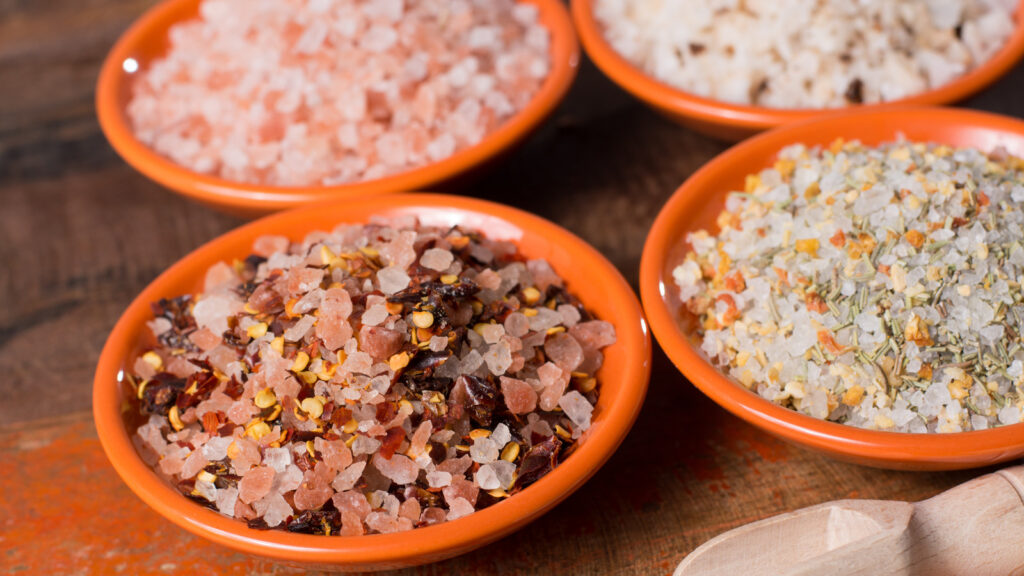Salt Types And Uses – 24
Salt Types And Uses
From its crystalline simplicity, salt transcends to become a cornerstone of gastronomic, industrial, and cultural significance. Salt is a modest mineral that has played a vital part in human history and is an essential element in our everyday lives.
Salt, which is mostly sodium chloride, is widely available in many forms and has influenced how we season, preserve, and enjoy food. Its influence reaches far beyond the kitchen, impacting trade routes, economics, and even cultural customs.

There are several Salt Types And Uses and each has special qualities and applications. Following are some typical
Salt Types And Uses and their associated applications:
Table salt -chloride of sodium Frequently used for seasoning and regular cooking. It is the kind of salt that is most frequently seen in homes.
Kosher salt
Uses: It’s widely used in everyday cooking as well as the koshering of meats. Because of the bigger crystals, it works well for extracting moisture from meats.
Added Spice to Salt:
Applications include combining table salt with spices, herbs, and occasionally monosodium glutamate (MSG). As an easy-to-use seasoning for any purpose.
Uses: Gives food a hint of brininess. It can be used as a finishing salt or in cooking, and its textures range from fine to coarse.
Follow Our Digiknowledge.co.in Page for Latest update about Bikes, Cars, Sports, , Life style and many more.
Pink Himalayan Salt:
Uses: Gives food a delicate, distinctive flavor and a pink tint. frequently used in gourmet cooking and as a finishing salt.
Salt Flakes (like Maldon):
Uses: Offers a light, delicate texture with thin, flat crystals. Perfect for topping off foods like desserts and salads.
Salt that has been smoked:
Uses: Emulsified with smoke flavour, it gives food a smoky flavour. frequently used for grilling and barbecues.
Kala Namak, or black salt:
Uses: Added to chaats, chutneys, and fruit salads, it is a common ingredient in Indian cuisine and has a characteristic sulphurous aroma.
Rock Salt:
Uses: Frequently used to manufacture ice packs and in ice cream makers. It’s also a component of various traditional cooking techniques and food preservation.
Pickling Salted Food:
Uses: Pickling and preservation are the main uses for unadulterated, pure salt. Pickling liquids are clear since they don’t contain any anti-caking ingredients.
Light or low-sodium salt:
Uses: Because it is made with less sodium, it is appropriate for people following a low-sodium diet.
Seasoned salt
Uses: Combine table salt with spices, herbs, and occasionally monosodium glutamate (MSG). used as an easy-to-use spice for everything.
Although salt enhances flavour in food, overindulging in it can lead to health problems. As part of a balanced diet, it’s critical to utilise salt in moderation.
Furthermore, certain specialty salts could be more costly, so using them for specific culinary purposes or as finishing touches to improve a dish’s appearance and flavor might be more appropriate.

What is the Ayurvedic importance of salt for health?
Salt is regarded as an essential component of Ayurveda, an age-old Indian traditional medical system, and plays a number of significant roles in preserving health. Here are several Ayurvedic viewpoints on the health benefits of salt:
Maintaining Doshas in Balance:
The three doshas of vata, pitta, and kapha make up the human body, according to Ayurveda. It is thought that salt can help balance these doshas. Consuming too much or too little salt can throw off the doshic balance and cause a number of health problems.
Gastrointestinal assistance
In Ayurveda, salt is seen as a digestive stimulant. It facilitates the secretion of digestive juices and enzymes, which aids in the effective breakdown and absorption of nutrients. This is especially important for people whose constitutions are mostly Vata, as they could benefit from a modest intake of salt.
Electrolyte Equilibrium:
Sodium and chloride, two important electrolytes, can be found in salt. These electrolytes are essential for sustaining the body’s ideal fluid balance, promoting nerve transmission, and guaranteeing adequate muscular contraction. According to Ayurveda, maintaining a proper electrolyte balance is crucial for general health.
Removal of Toxins and Purification:
In Ayurveda, salt is thought to have cleansing qualities. For example, gargling with saltwater is thought to help with infection prevention and mouth hygiene. Furthermore, salt is utilized in a number of Ayurvedic detoxification procedures, like saltwater flushes, to remove toxins from the body.

Developing Taste
In Ayurveda, salt is considered one of the six basic tastes, or shad rasa. It is believed that food’s overall enjoyment, hunger stimulation, and digestion are all aided by its salty flavor. For a diet to be well-rounded and nourishing, it is thought to be vital to balance this taste with other tastes like sweet, sour, bitter, pungent, and astringent.
Preserving Fluid Equilibrium:
Maintaining the body’s ideal fluid equilibrium is crucial, according to Ayurveda. Salt is essential for controlling fluid balance and avoiding dehydration. It is advised against consuming too much salt, though, as this might cause imbalances and health problems.
Ayurvedic advice is customized based on an individual’s constitution (Prakriti), present imbalances (Vikriti), and other considerations.
To guarantee individualized guidance that is in line with one’s specific needs and conditions, speaking with a competent Ayurvedic practitioner is advised as with any dietary or health-related advice.
Which salt is used for cooking?
The crystals in kosher salt are easily squeezed between your fingers, making it perfect for cooking.
Can we eat all types of salt?
Every salt has its uses. There are other varieties of salts that are not meant for human ingestion, such as Epsom salt and rock salt, even though table salt and sea salt are frequently used for cooking and seasoning.
Which salt is not harmful?
Since potassium salts contain up to 70% less sodium than regular table salt, they are not as dangerous as salts based on sodium. Given that potassium is an antagonist of sodium, potassium salts may potentially lower blood pressure.




